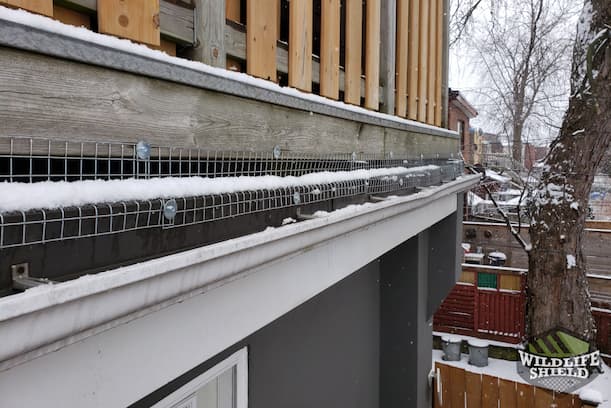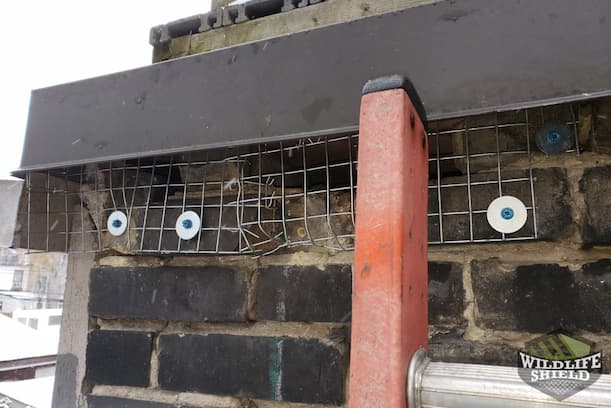The following article recounts a raccoon and squirrel removal service in Old Toronto. Both squirrels and raccoons were found living under a second-storey deck, causing damage to the roof and posing a health hazard to the inhabitants of the home. The animals were safely evicted from the property and fully excluded with a comprehensive wildlife-proofing of the deck.
Inspection
The owner of this semi-detached home called Squirrel Control when they suspected that squirrels were living under their second-storey deck. They could hear the animals scratching, thumping and squealing in there and there was an abundance of squirrel activity on their property. Squirrels are common in Old Toronto and known to break into raised structures like attics and balconies.
A technician soon arrived to investigate the problem. With every inspection, our experts look closely for signs of animal activity and any vulnerabilities that can lead to another infestation in the future. In this case, the exterior of the deck was examined for points of entry and evidence of a squirrel’s nest. There was a clear gap between the deck and the roof below, giving animals enough space to move in and out very easily. Squirrels were likely nesting within this gap as there was plenty of foliage and debris within this gap.
In addition to the space between the deck and the roof, the technician found a hole in the roof’s edge that was wide enough to fit a raccoon. Raccoons are also common in Old Toronto. These animals feed on the garbage that is left out by the road as well the fruits and vegetables that people grow in their gardens. Like squirrels, raccoons are attracted to attics and other raised structures that shelter them from the elements. It was likely that both raccoons and squirrels were taking advantage of this second-storey deck and making it their home.
Given the damage on the roof and the space beneath the deck, the technician on-site recommended having both species removed and excluded from the roof as soon as possible. This would involve the installation of one-way doors to let the animals out safely, plus screwing mesh into the sides of the deck to prevent this from happening again. While they may be cute, squirrels and raccoons are both tremendously destructive. The longer the wait, the worse the damage would get. The homeowner then agreed to have the work done, and the technician got started right away.
Removal and Permanent Exclusion
First, the technician screwed a galvanized steel mesh into the sides of the deck. This is a flexible, weather-proof material that resists animal chewing and tearing, so it would keep animals out of the space beneath the deck. Two gaps on the side of the house, between the brick and the edge of the roof, were also excluded with mesh.


Once the mesh was installed, the technician proceeded to place the one-way doors. The one-way door for squirrels consists of a tube made of galvanized steel mesh with a flap that swings outward, letting squirrels out safely while blocking their re-entry. This one-way door was placed with the mesh surrounding it so that the squirrel would have no other way out. Once out, it would find another place to live. Squirrels usually keep several nests handy in case they need to relocate.

The one-way door for raccoons is larger and consists of a plexiglass flap surrounded by mesh. This was installed right on top of the hole the technician found earlier. Within a few days, the raccoons would have to leave their den to feed. Once out the one-way door, like the squirrel, it would need to find a new home. Raccoons are resourceful animals that know their neighbourhoods well. The animal would likely move to another one of its dens or make a new one somewhere nearby.

Within a few days, the homeowner stopped hearing noises in the ceiling of the first floor and noticed that there was a reduction in animal activity near the deck. The animals had left through the one-way doors. A few days after that, the technician returned to the property to remove the one-way doors are replace them with more mesh. This would ensure that the animals could not break back in where they entered before.
Conclusion
Squirrels and raccoons are common throughout Old Toronto and they will absolutely take advantage of the gaps and cracks along with the structure of your home. This case study demonstrates how important it is to maintain your roof and to hire a professional that can handle any wildlife issue should you need anything removed. The technicians at Squirrel Control are thoroughly trained and experienced in all forms of wildlife removal and have the tools to provide you with lasting solutions, no matter the situation. If you have any questions, or if you’d like to book an inspection, give Squirrel Control a call: 647-496-0815.
